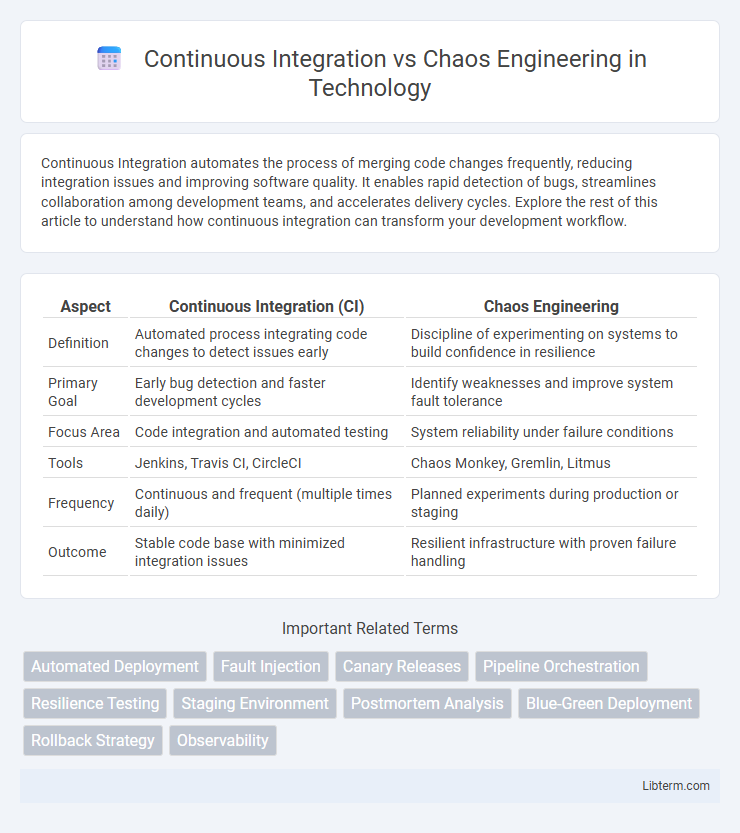Continuous Integration automates the process of merging code changes frequently, reducing integration issues and improving software quality. It enables rapid detection of bugs, streamlines collaboration among development teams, and accelerates delivery cycles. Explore the rest of this article to understand how continuous integration can transform your development workflow.
Table of Comparison
| Aspect | Continuous Integration (CI) | Chaos Engineering |
|---|---|---|
| Definition | Automated process integrating code changes to detect issues early | Discipline of experimenting on systems to build confidence in resilience |
| Primary Goal | Early bug detection and faster development cycles | Identify weaknesses and improve system fault tolerance |
| Focus Area | Code integration and automated testing | System reliability under failure conditions |
| Tools | Jenkins, Travis CI, CircleCI | Chaos Monkey, Gremlin, Litmus |
| Frequency | Continuous and frequent (multiple times daily) | Planned experiments during production or staging |
| Outcome | Stable code base with minimized integration issues | Resilient infrastructure with proven failure handling |
Introduction to Continuous Integration and Chaos Engineering
Continuous Integration (CI) is a software development practice where developers frequently merge code changes into a central repository, triggering automated builds and tests to detect early integration issues. Chaos Engineering focuses on proactively injecting faults and failures into complex systems to evaluate resilience and identify vulnerabilities before they impact users. Both methodologies aim to improve software reliability but approach quality assurance from continuous validation versus intentional disruption perspectives.
Core Principles of Continuous Integration
Continuous Integration (CI) emphasizes frequent code integration into a shared repository, automated testing, and immediate feedback to detect defects early. Core principles include maintaining a single source repository, automating the build process, running tests continuously, and ensuring every change is verified before integration. Unlike Chaos Engineering, which focuses on testing system resilience under failure conditions, CI aims to improve code quality and accelerate development cycles through consistent validation and rapid error detection.
Core Principles of Chaos Engineering
Chaos Engineering emphasizes proactively experimenting on distributed systems to build confidence in their resilience by intentionally introducing failures and observing system behavior under stress. Its core principles include defining steady state as measurable system behavior, creating hypotheses about system stability, conducting controlled experiments that inject faults, and learning from failures to improve system reliability. Continuous Integration, in contrast, centers on automating code integration and testing to detect errors early, but Chaos Engineering extends this by validating real-world system robustness beyond standard automated tests.
Key Differences Between Continuous Integration and Chaos Engineering
Continuous Integration (CI) focuses on automated code integration and testing to ensure consistent software quality and faster delivery cycles, whereas Chaos Engineering emphasizes deliberately injecting faults into systems to identify weaknesses and improve system resilience. CI primarily targets early bug detection and seamless collaboration among developers, while Chaos Engineering targets reliability by simulating real-world failure scenarios in production or staging environments. The key difference lies in CI's proactive approach to preventing defects versus Chaos Engineering's reactive strategy to validate system stability under unpredictable conditions.
Benefits of Implementing Continuous Integration
Implementing Continuous Integration (CI) significantly enhances development efficiency by automating code integration and testing, reducing integration errors and accelerating release cycles. CI fosters early detection of defects, improving software quality and enabling rapid feedback for developers. This streamlined workflow supports continuous delivery and deployment, promoting collaboration and maintaining stable, reliable software in complex environments.
Advantages of Embracing Chaos Engineering
Chaos Engineering enhances system resilience by proactively identifying vulnerabilities through controlled experiments that mimic real-world failures. Unlike Continuous Integration, which primarily automates code integration and testing, Chaos Engineering exposes hidden weaknesses under unpredictable conditions, enabling teams to build more fault-tolerant infrastructures. Embracing Chaos Engineering leads to improved uptime, faster recovery times, and increased confidence in system stability during unexpected disruptions.
How Continuous Integration and Chaos Engineering Complement Each Other
Continuous Integration (CI) automates software testing and integration to ensure rapid, reliable code updates, while Chaos Engineering systematically introduces faults to identify system weaknesses under real-world conditions. By combining CI's automated validation pipelines with Chaos Engineering's resilience testing, development teams can detect bugs early and validate system robustness simultaneously. This integration enhances software quality by accelerating delivery and proactively preventing failures in production environments.
Common Challenges in CI and Chaos Engineering Adoption
Continuous Integration (CI) and Chaos Engineering both face common adoption challenges such as tool complexity, cultural resistance, and lack of expertise, resulting in implementation delays. CI struggles with ensuring consistent build environments and managing test flakiness, while Chaos Engineering's challenges revolve around designing safe, meaningful experiments without risking production stability. Organizations often encounter difficulty aligning cross-functional teams and integrating automated processes that balance rapid delivery with reliable incident response.
Real-World Examples: CI vs Chaos Engineering
Continuous Integration (CI) practices streamline software development by automating code integration and testing, as demonstrated by companies like Facebook, which deploys thousands of code changes daily with minimal disruption. In contrast, Chaos Engineering, famously utilized by Netflix, proactively injects failures into production environments to identify weaknesses and enhance system resilience. Combining CI's rapid feedback loops with Chaos Engineering's fault injection ensures robust, reliable software delivery in complex, real-world systems.
Best Practices for Integrating CI with Chaos Engineering
Integrating Continuous Integration (CI) with Chaos Engineering demands establishing automated, controlled chaos experiments within CI pipelines to identify potential system weaknesses early. Implementing frequent, small-scale fault injections combined with real-time monitoring and alerting enables teams to validate system resilience without disrupting deployment velocity. Best practices include creating clear rollback strategies, maintaining comprehensive incident documentation, and ensuring chaos experiments are reproducible and aligned with deployment cycles.
Continuous Integration Infographic

 libterm.com
libterm.com